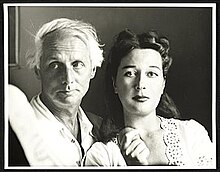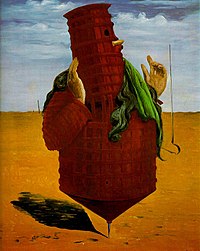


Μαξ Ερνστ

Ο Μαξ Ερνστ (Max Ernst, 2 Απριλίου 1891 - 1 Απριλίου 1976) ήταν Γερμανός ζωγράφος και γλύπτης και θεωρείται ένας από τους σημαντικότερους καλλιτέχνες του κινήματος του υπερρεαλισμού αλλά και εν γένει της μοντέρνας τέχνης. Η τέχνη του χαρακτηρίστηκε από πρωτοποριακά και ρηξικέλευθα στοιχεία, με εμφανείς επιρροές από το σουρρεαλιστικό κίνημα. Επιπλέον, ο Μαξ Ερνστ διακρίθηκε για το συνδυασμό διαφορετικών τεχνικών που χρησιμοποίησε, καθώς και από μία διαρκή αναζήτηση νέων μεθόδων σύνθεσης.
Γεννήθηκε στην πόλη Brühl της Γερμανίας, λίγο έξω από την Κολωνία, γιος του δάσκαλου Φίλιπ Ερνστ και της Λουΐζ Κοπ. Το 1909, σε ηλικία 18 ετών, ξεκινά η φοίτησή του στο Πανεπιστήμιο της Βόννης και ειδικότερα στη σχολή Φιλοσοφίας, ωστόσο σε σύντομο χρονικό διάστημα εγκαταλείπει ολοκληρωτικά τις σπουδές του προκειμένου να αφιερωθεί στην τέχνη. Το 1911 γνωρίζεται και συνδέεται φιλικά με τον Όγκουστ Μάκε, ενώ γίνεται και μέλος της μιας εξπρεσιονιστικής ομάδας καλλιτεχνών (Rheinische Expressionisten) στη Βόννη. Τον επόμενο χρόνο εκθέτει έργα του στην γκαλερί Feldman στην Κολωνία. Παράλληλα, έρχεται σε επαφή με το έργο του Σεζάν, του Πικάσσο και του Βαν Γκόγκ και το 1913 ταξιδεύει στο Παρίσι όπου γνωρίζει αρχικά τον ποιητή Γκιγιώμ Απολλιναίρ και αργότερα τον Ζαν Αρπ με τον οποίο θα αναπτύξει ιδιαίτερη φιλία.
Με το ξέσπασμα του Α' παγκοσμίου πολέμου. ο Ερνστ κατατάσσεται στο γερμανικό στρατό. Παρά την στρατιωτική του θητεία, εξακολουθεί να ζωγραφίζει και το 1916 συμμετέχει σε έκθεση στο Βερολίνο. Μετά το τέλος του πολέμου, επιστρέφει στην Κολωνία το 1918, όπου πραγματοποιεί τα πρώτα του έργα κολάζ ενώ συμμετέχει ενεργά και στη σύσταση της ντανταϊστικής ομάδας στην Κολωνία. Το 1921 εκθέτει για πρώτη φορά έργα του στο Παρίσι και την ίδια περίπου περίοδο αναμειγνύεται στις δραστηριότητες των Γάλλων υπερρεαλιστών. Καταγράφονται και αρκετές συνεργασίες του με άλλους υπερρεαλιστές καλλιτέχνες, όπως τον Πωλ Ελυάρ, τον Χουάν Μιρό αλλά και τον σκηνοθέτη Λουίς Μπουνιουέλ, με τον οποίο συνεργάζεται για την ταινία Χρυσή Εποχή όπου υποδύεται και έναν μικρό ρόλο.
Το 1926 εκδίδει το έργο Φυσική Ιστορία χρησιμοποιώντας την τεχνική του φροτάζ και τρία χρόνια αργότερα εκδίδει το πρώτο μυθιστόρημα-κολάζ με τίτλο Η Γυναίκα Με Τα 100 Κεφάλια. Το 1931 εκθέτει για πρώτη φορά στην Αμερική, στη Julian Levy Gallery της Νέας Υόρκης και με την έναρξη του Β' παγκοσμίου πολέμου αναζητά και πάλι καταφύγιο στις Ηνωμένες Πολιτείες, όπου κατορθώνει να εγκατασταθεί χάρη στη βοήθεια του αμερικανού δημοσιογράφου Varian Fry, το 1941. Στην Αμερική, συνδέεται με τον Μαρσέλ Ντυσάν και θεωρείται πως αποτελεί κατά κάποιο τρόπο επιρροή των καλλιτεχνών του αφηρημένος εξπρεσιονισμού.
Ο Ερνστ επιστρέφει στην Ευρώπη το 1950 και το 1954 του απονέμεται το πρώτο βραβείο ζωγραφικής στη Μπιενάλε της Βενετίας. Μια σημαντική αναδρομική έκθεση με έργα του παρουσιάζεται στο Μουσείο Guggenheim της Νέας Υόρκης. Πεθαίνει τον επόμενο χρόνο στο Παρίσι.
Max Ernst
| Max Ernst | |
 Max Ernst and Dorothea Tanning in 1948 | |
| Born | April 2, 1891 Brühl, Germany |
| Died | April 1, 1976 (aged 84) Paris, France |
| Nationality | German |
| Field | painting, sculpture, poetry |
| Movement | Dada, Surrealism |
Max Ernst (2 April 1891 - 1 April 1976) was a German painter, sculptor, graphic artist, and poet, considered one of the chief representatives of Dadaism and Surrealism.
Contents[hide] |
Early life
Max Ernst was born in Brühl, Germany, near Cologne. In 1909, he enrolled in the University at Bonn to study philosophy but soon abandoned the courses. He began painting that year, but never received any formal artistic training.[1]
During World War I he served in the German army, which was a momentous interruption in his career as an artist. He stated in his autobiography, "Max Ernst died the 1st of August, 1914."
Dada & Surrealism
After the war, filled with new ideas, Ernst, Jean Arp and social activist Alfred Grünwald, formed the Cologne, Germany Dada group. In 1918 he married the art historian Luise Straus - a stormy relationship that would not last. The couple had a son who was born in 1920, the artist Jimmy Ernst. (Luise died in Auschwitz in 1944.[2]) In 1919 Ernst visited Paul Klee and created paintings, block prints and collages, and experimented with mixed media.
In 1922, he joined fellow Dadaists André Breton, Gala, Tristan Tzara, Paul Éluard at the artistic community of Montparnasse.[1] Constantly experimenting, in 1925 he invented a graphic art technique called frottage, which uses pencil rubbings of objects as a source of images.
The next year he collaborated with Joan Miró on designs for Sergei Diaghilev. With Miró's help, Ernst pioneered grattage in which he troweled pigment from his canvases. He also explored with the technique of decalcomania which involves pressing paint between two surfaces.[3]
Ernst developed a fascination with birds that was prevalent in his work. His alter ego in paintings, which he called Loplop, was a bird. He suggested this alter-ego was an extension of himself stemming from an early confusion of birds and humans. He said his sister was born soon after his bird died. Loplop often appeared in collages of other artists' work, such as Loplop presents André Breton. Ernst drew a great deal of controversy with his 1926 painting The Virgin Chastises the infant Jesus before Three Witnesses: André Breton, Paul Éluard, and the Painter.[4] In 1927 he married Marie-Berthe Aurenche, and it is thought his relationship with her may have inspired the erotic subject matter of The Kiss and other works of this year.[5] In 1930, he appeared in the film "L'age d'or" directed jointly by Salvador Dali and Luis Bunuel. Ernst began to make sculpture in 1934, and spent time with Alberto Giacometti. In 1938, the American heiress and artistic patron Peggy Guggenheim acquired a number of Max Ernst's works which she displayed in her new museum in London.
World War II and after
With the outbreak of World War II, Ernst was arrested by French authorities as a "hostile alien". Thanks to the intercession of Paul Eluard, and other friends including the journalist Varian Fry he was discharged a few weeks later. Soon after the Nazi occupation of France, he was arrested again, this time by the Gestapo, but managed to escape and flee to America with the help of Guggenheim.[1] He left behind his lover, Leonora Carrington, and she suffered a major mental breakdown. Ernst and Guggenheim arrived in the United States in 1941 and were married the following year. Along with other artists and friends (Marcel Duchamp and Marc Chagall) who had fled from the war and lived in New York City, Ernst helped inspire the development of Abstract expressionism.
His marriage to Guggenheim did not last, and in Beverly Hills, California in October of 1946, in a double ceremony with Man Ray and Juliet Browner, he married Dorothea Tanning. The couple first made their home in Sedona, Arizona. In 1948 Ernst wrote the treatise Beyond Painting. As a result of the publicity, he began to achieve financial success.
In 1953 he and Tanning moved to a small town in the south of France where he continued to work. The City, and the Galeries Nationales du Grand-Palais in Paris published a complete catalogue of his works.
Ernst died on 1 April 1976, in Paris.[1] He was interred there at the Père Lachaise Cemetery

- Trophy, Hypertrophied (1919)
- Aquis Submersus (1919)
- Little Machine Constructed by Minimax Dadamax in Person (1919-1920)
- The Hat Makes the Man (1920)
- Murdering Airplane (1920)
- The Elephant Celebes (1921)
- Pietà or Revolution by Night (1923)
- Forest and Dove (1927)
- The Wood (1927)
- Loplop Introduces Loplop (1930)
- Une Semaine de Bonté (1934)
Ernst in modern culture
- Many of Ernst's works from Une Semaine de Bonté are used in albums by American rock group The Mars Volta, and Barefoot In The Head, a collaboration between guitarist Thurston Moore and saxophonists Jim Sauter and Don Dietrich of Borbetomagus, features a collage from this same book.
- The American rock group Mission of Burma titled two songs after the artist: "Max Ernst" was the b-side of their first 1978 single (now included on the CD of Signals, Calls and Marches), mentioning two of Ernst's paintings (The Blessed Virgin Chastises the Infant Jesus and Garden Airplane-Trap) and ending with the words "Dada dada dada ..." repeated many times and distorted via tape loop; their 2002 album OnOffOn features "Max Ernst's Dream".





Δεν υπάρχουν σχόλια:
Δημοσίευση σχολίου